Analysis of Health Policy, Power, and Politics Assignment
VerifiedAdded on 2022/09/07
|8
|2376
|19
Homework Assignment
AI Summary
This assignment analyzes various aspects of health policy, power, and politics. It addresses the differences between government policies and health policies, emphasizing the role of the Ministry of Health. The assignment explores the factors influencing community and individual health, including education, wealth, and living conditions. It also examines obesity as a significant health risk and discusses strategies for tobacco control within universities, considering factors like campus culture and available resources. Furthermore, it defines and discusses 'wicked problems' in health policy, highlighting the challenges in finding solutions due to complex and evolving requirements. The assignment references key literature to support its arguments, covering topics such as policy implementation, determinants of health, and the impact of social and political factors on health outcomes.
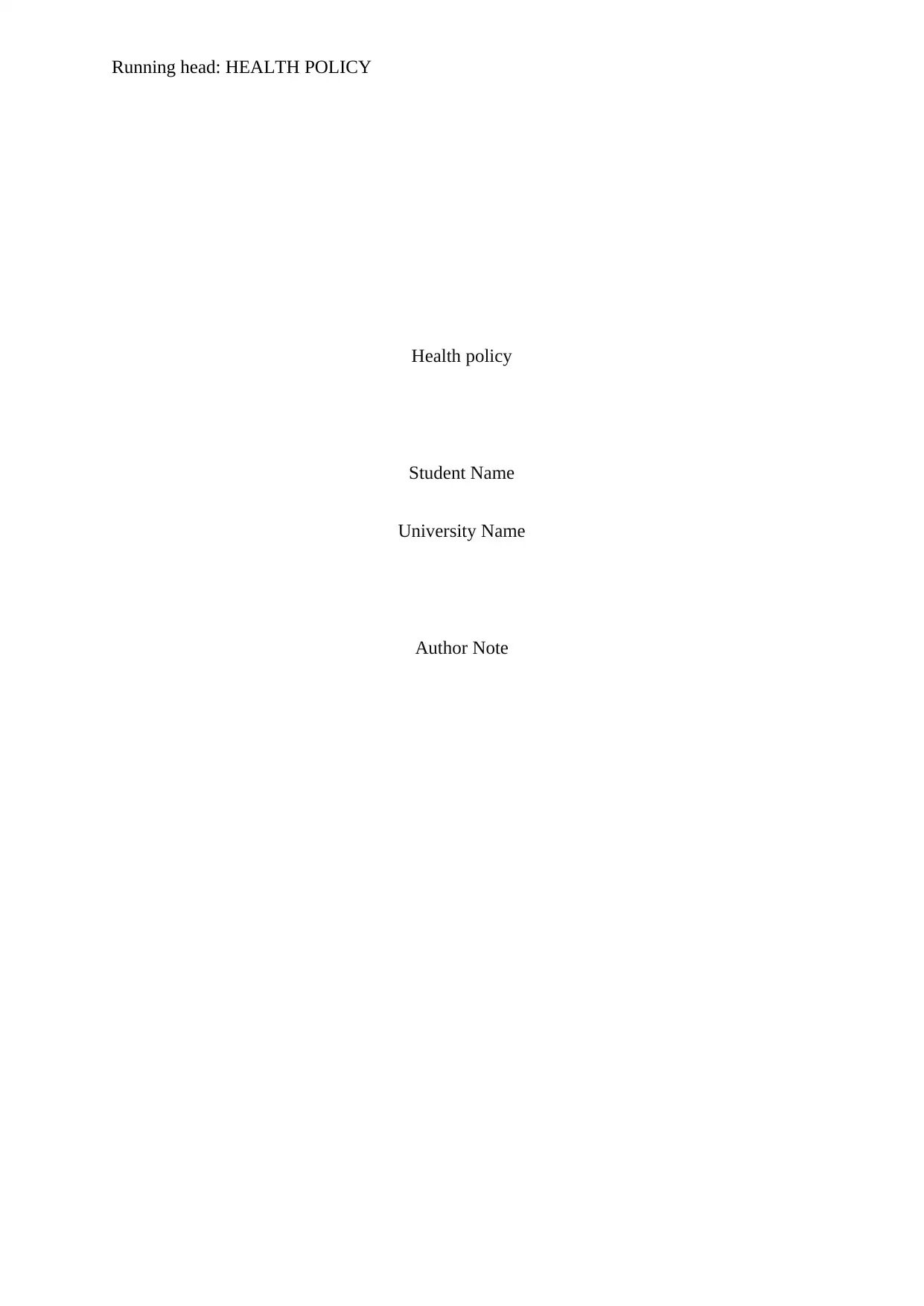
Running head: HEALTH POLICY
Health policy
Student Name
University Name
Author Note
Health policy
Student Name
University Name
Author Note
Paraphrase This Document
Need a fresh take? Get an instant paraphrase of this document with our AI Paraphraser
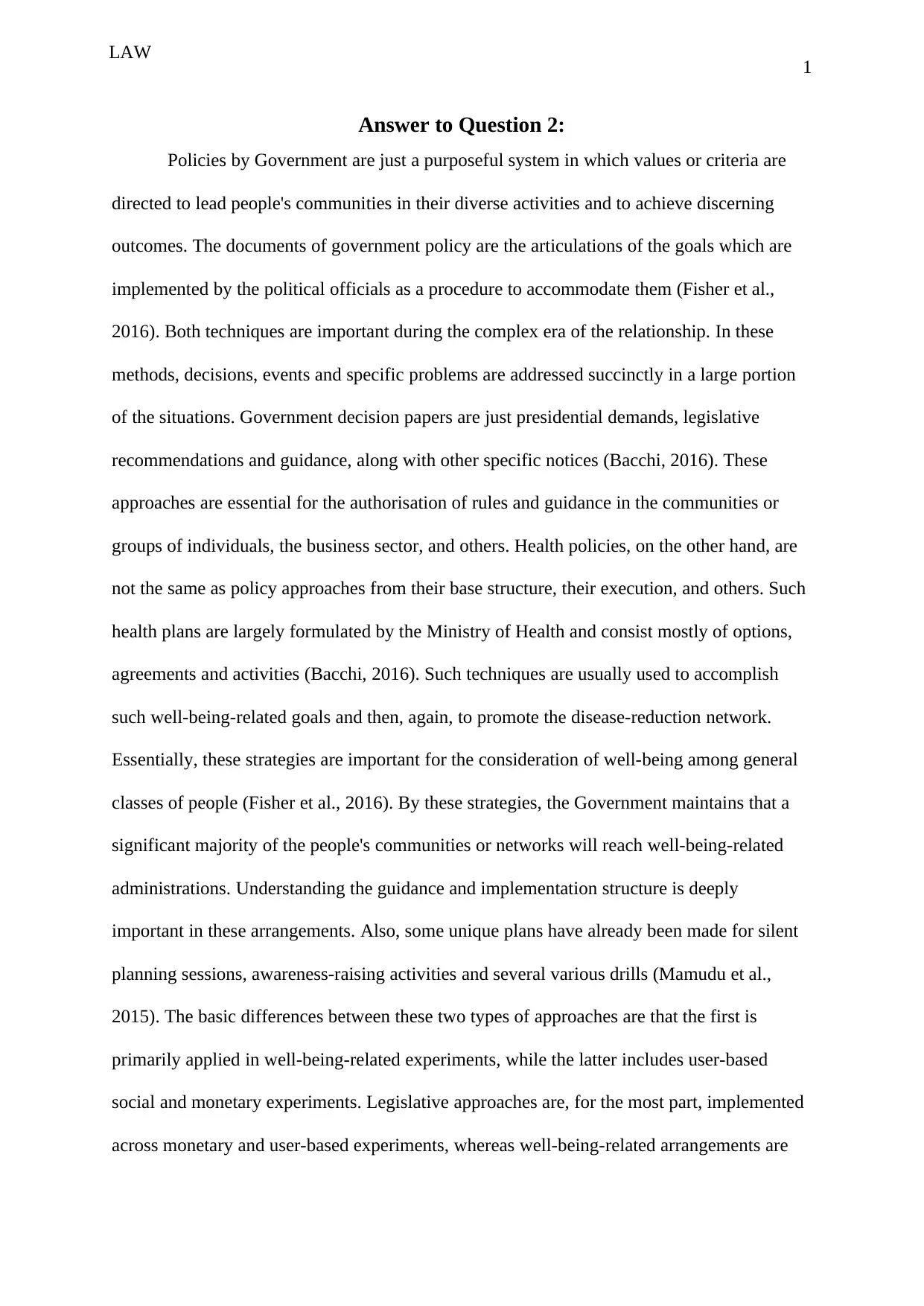
1
Answer to Question 2:
Policies by Government are just a purposeful system in which values or criteria are
directed to lead people's communities in their diverse activities and to achieve discerning
outcomes. The documents of government policy are the articulations of the goals which are
implemented by the political officials as a procedure to accommodate them (Fisher et al.,
2016). Both techniques are important during the complex era of the relationship. In these
methods, decisions, events and specific problems are addressed succinctly in a large portion
of the situations. Government decision papers are just presidential demands, legislative
recommendations and guidance, along with other specific notices (Bacchi, 2016). These
approaches are essential for the authorisation of rules and guidance in the communities or
groups of individuals, the business sector, and others. Health policies, on the other hand, are
not the same as policy approaches from their base structure, their execution, and others. Such
health plans are largely formulated by the Ministry of Health and consist mostly of options,
agreements and activities (Bacchi, 2016). Such techniques are usually used to accomplish
such well-being-related goals and then, again, to promote the disease-reduction network.
Essentially, these strategies are important for the consideration of well-being among general
classes of people (Fisher et al., 2016). By these strategies, the Government maintains that a
significant majority of the people's communities or networks will reach well-being-related
administrations. Understanding the guidance and implementation structure is deeply
important in these arrangements. Also, some unique plans have already been made for silent
planning sessions, awareness-raising activities and several various drills (Mamudu et al.,
2015). The basic differences between these two types of approaches are that the first is
primarily applied in well-being-related experiments, while the latter includes user-based
social and monetary experiments. Legislative approaches are, for the most part, implemented
across monetary and user-based experiments, whereas well-being-related arrangements are
LAW
Answer to Question 2:
Policies by Government are just a purposeful system in which values or criteria are
directed to lead people's communities in their diverse activities and to achieve discerning
outcomes. The documents of government policy are the articulations of the goals which are
implemented by the political officials as a procedure to accommodate them (Fisher et al.,
2016). Both techniques are important during the complex era of the relationship. In these
methods, decisions, events and specific problems are addressed succinctly in a large portion
of the situations. Government decision papers are just presidential demands, legislative
recommendations and guidance, along with other specific notices (Bacchi, 2016). These
approaches are essential for the authorisation of rules and guidance in the communities or
groups of individuals, the business sector, and others. Health policies, on the other hand, are
not the same as policy approaches from their base structure, their execution, and others. Such
health plans are largely formulated by the Ministry of Health and consist mostly of options,
agreements and activities (Bacchi, 2016). Such techniques are usually used to accomplish
such well-being-related goals and then, again, to promote the disease-reduction network.
Essentially, these strategies are important for the consideration of well-being among general
classes of people (Fisher et al., 2016). By these strategies, the Government maintains that a
significant majority of the people's communities or networks will reach well-being-related
administrations. Understanding the guidance and implementation structure is deeply
important in these arrangements. Also, some unique plans have already been made for silent
planning sessions, awareness-raising activities and several various drills (Mamudu et al.,
2015). The basic differences between these two types of approaches are that the first is
primarily applied in well-being-related experiments, while the latter includes user-based
social and monetary experiments. Legislative approaches are, for the most part, implemented
across monetary and user-based experiments, whereas well-being-related arrangements are
LAW
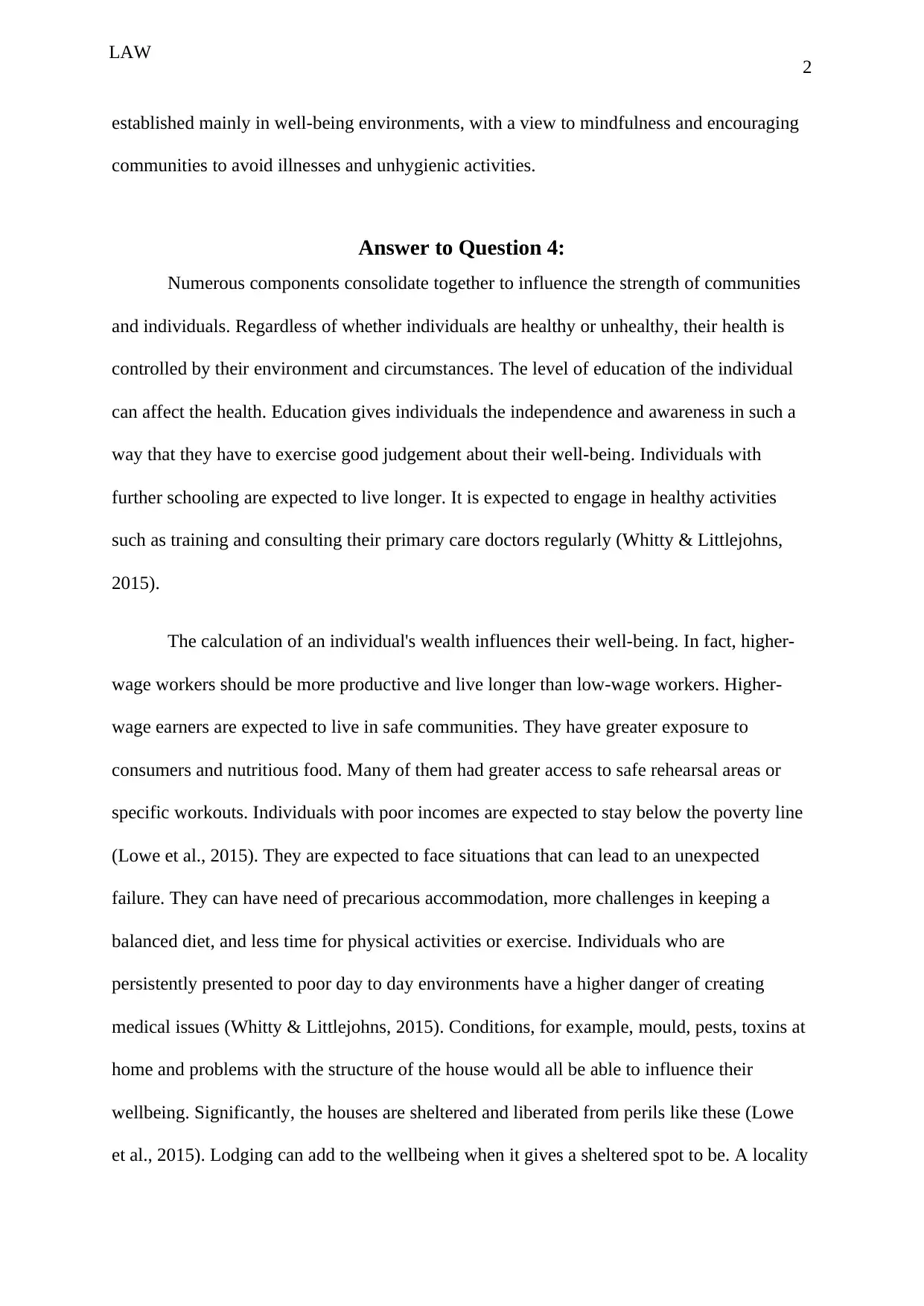
2
established mainly in well-being environments, with a view to mindfulness and encouraging
communities to avoid illnesses and unhygienic activities.
Answer to Question 4:
Numerous components consolidate together to influence the strength of communities
and individuals. Regardless of whether individuals are healthy or unhealthy, their health is
controlled by their environment and circumstances. The level of education of the individual
can affect the health. Education gives individuals the independence and awareness in such a
way that they have to exercise good judgement about their well-being. Individuals with
further schooling are expected to live longer. It is expected to engage in healthy activities
such as training and consulting their primary care doctors regularly (Whitty & Littlejohns,
2015).
The calculation of an individual's wealth influences their well-being. In fact, higher-
wage workers should be more productive and live longer than low-wage workers. Higher-
wage earners are expected to live in safe communities. They have greater exposure to
consumers and nutritious food. Many of them had greater access to safe rehearsal areas or
specific workouts. Individuals with poor incomes are expected to stay below the poverty line
(Lowe et al., 2015). They are expected to face situations that can lead to an unexpected
failure. They can have need of precarious accommodation, more challenges in keeping a
balanced diet, and less time for physical activities or exercise. Individuals who are
persistently presented to poor day to day environments have a higher danger of creating
medical issues (Whitty & Littlejohns, 2015). Conditions, for example, mould, pests, toxins at
home and problems with the structure of the house would all be able to influence their
wellbeing. Significantly, the houses are sheltered and liberated from perils like these (Lowe
et al., 2015). Lodging can add to the wellbeing when it gives a sheltered spot to be. A locality
LAW
established mainly in well-being environments, with a view to mindfulness and encouraging
communities to avoid illnesses and unhygienic activities.
Answer to Question 4:
Numerous components consolidate together to influence the strength of communities
and individuals. Regardless of whether individuals are healthy or unhealthy, their health is
controlled by their environment and circumstances. The level of education of the individual
can affect the health. Education gives individuals the independence and awareness in such a
way that they have to exercise good judgement about their well-being. Individuals with
further schooling are expected to live longer. It is expected to engage in healthy activities
such as training and consulting their primary care doctors regularly (Whitty & Littlejohns,
2015).
The calculation of an individual's wealth influences their well-being. In fact, higher-
wage workers should be more productive and live longer than low-wage workers. Higher-
wage earners are expected to live in safe communities. They have greater exposure to
consumers and nutritious food. Many of them had greater access to safe rehearsal areas or
specific workouts. Individuals with poor incomes are expected to stay below the poverty line
(Lowe et al., 2015). They are expected to face situations that can lead to an unexpected
failure. They can have need of precarious accommodation, more challenges in keeping a
balanced diet, and less time for physical activities or exercise. Individuals who are
persistently presented to poor day to day environments have a higher danger of creating
medical issues (Whitty & Littlejohns, 2015). Conditions, for example, mould, pests, toxins at
home and problems with the structure of the house would all be able to influence their
wellbeing. Significantly, the houses are sheltered and liberated from perils like these (Lowe
et al., 2015). Lodging can add to the wellbeing when it gives a sheltered spot to be. A locality
LAW
⊘ This is a preview!⊘
Do you want full access?
Subscribe today to unlock all pages.

Trusted by 1+ million students worldwide
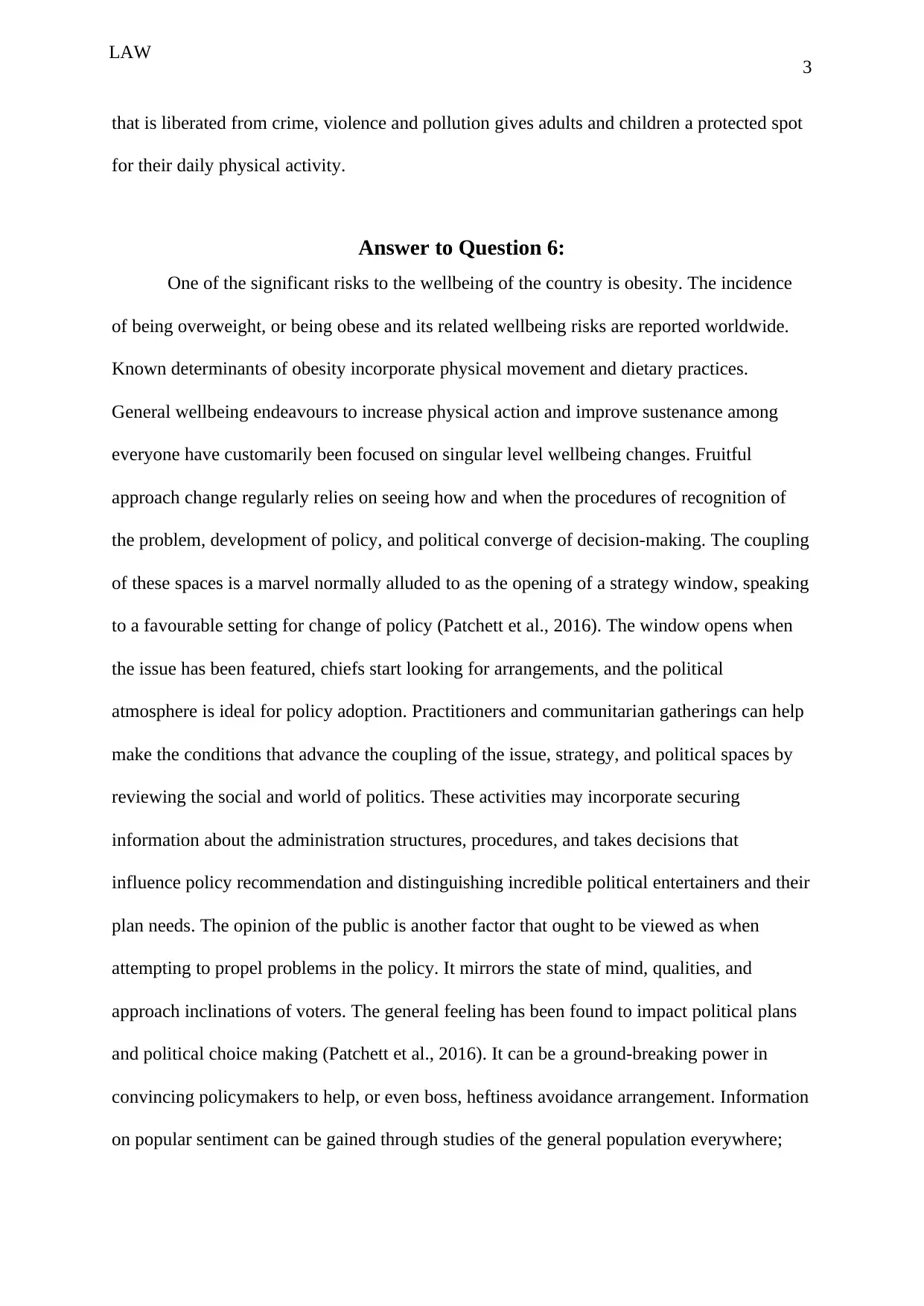
3
that is liberated from crime, violence and pollution gives adults and children a protected spot
for their daily physical activity.
Answer to Question 6:
One of the significant risks to the wellbeing of the country is obesity. The incidence
of being overweight, or being obese and its related wellbeing risks are reported worldwide.
Known determinants of obesity incorporate physical movement and dietary practices.
General wellbeing endeavours to increase physical action and improve sustenance among
everyone have customarily been focused on singular level wellbeing changes. Fruitful
approach change regularly relies on seeing how and when the procedures of recognition of
the problem, development of policy, and political converge of decision-making. The coupling
of these spaces is a marvel normally alluded to as the opening of a strategy window, speaking
to a favourable setting for change of policy (Patchett et al., 2016). The window opens when
the issue has been featured, chiefs start looking for arrangements, and the political
atmosphere is ideal for policy adoption. Practitioners and communitarian gatherings can help
make the conditions that advance the coupling of the issue, strategy, and political spaces by
reviewing the social and world of politics. These activities may incorporate securing
information about the administration structures, procedures, and takes decisions that
influence policy recommendation and distinguishing incredible political entertainers and their
plan needs. The opinion of the public is another factor that ought to be viewed as when
attempting to propel problems in the policy. It mirrors the state of mind, qualities, and
approach inclinations of voters. The general feeling has been found to impact political plans
and political choice making (Patchett et al., 2016). It can be a ground-breaking power in
convincing policymakers to help, or even boss, heftiness avoidance arrangement. Information
on popular sentiment can be gained through studies of the general population everywhere;
LAW
that is liberated from crime, violence and pollution gives adults and children a protected spot
for their daily physical activity.
Answer to Question 6:
One of the significant risks to the wellbeing of the country is obesity. The incidence
of being overweight, or being obese and its related wellbeing risks are reported worldwide.
Known determinants of obesity incorporate physical movement and dietary practices.
General wellbeing endeavours to increase physical action and improve sustenance among
everyone have customarily been focused on singular level wellbeing changes. Fruitful
approach change regularly relies on seeing how and when the procedures of recognition of
the problem, development of policy, and political converge of decision-making. The coupling
of these spaces is a marvel normally alluded to as the opening of a strategy window, speaking
to a favourable setting for change of policy (Patchett et al., 2016). The window opens when
the issue has been featured, chiefs start looking for arrangements, and the political
atmosphere is ideal for policy adoption. Practitioners and communitarian gatherings can help
make the conditions that advance the coupling of the issue, strategy, and political spaces by
reviewing the social and world of politics. These activities may incorporate securing
information about the administration structures, procedures, and takes decisions that
influence policy recommendation and distinguishing incredible political entertainers and their
plan needs. The opinion of the public is another factor that ought to be viewed as when
attempting to propel problems in the policy. It mirrors the state of mind, qualities, and
approach inclinations of voters. The general feeling has been found to impact political plans
and political choice making (Patchett et al., 2016). It can be a ground-breaking power in
convincing policymakers to help, or even boss, heftiness avoidance arrangement. Information
on popular sentiment can be gained through studies of the general population everywhere;
LAW
Paraphrase This Document
Need a fresh take? Get an instant paraphrase of this document with our AI Paraphraser
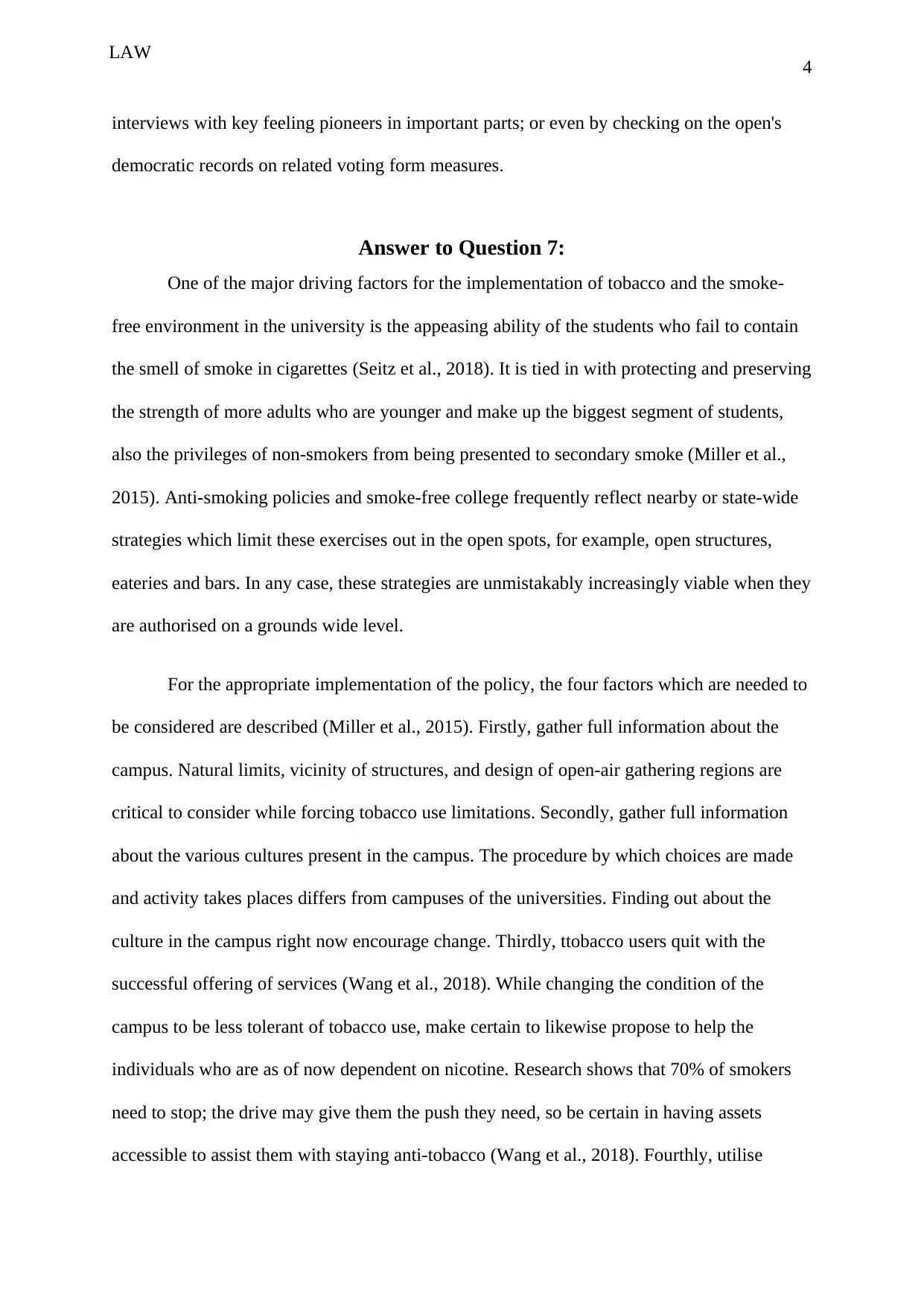
4
interviews with key feeling pioneers in important parts; or even by checking on the open's
democratic records on related voting form measures.
Answer to Question 7:
One of the major driving factors for the implementation of tobacco and the smoke-
free environment in the university is the appeasing ability of the students who fail to contain
the smell of smoke in cigarettes (Seitz et al., 2018). It is tied in with protecting and preserving
the strength of more adults who are younger and make up the biggest segment of students,
also the privileges of non-smokers from being presented to secondary smoke (Miller et al.,
2015). Anti-smoking policies and smoke-free college frequently reflect nearby or state-wide
strategies which limit these exercises out in the open spots, for example, open structures,
eateries and bars. In any case, these strategies are unmistakably increasingly viable when they
are authorised on a grounds wide level.
For the appropriate implementation of the policy, the four factors which are needed to
be considered are described (Miller et al., 2015). Firstly, gather full information about the
campus. Natural limits, vicinity of structures, and design of open-air gathering regions are
critical to consider while forcing tobacco use limitations. Secondly, gather full information
about the various cultures present in the campus. The procedure by which choices are made
and activity takes places differs from campuses of the universities. Finding out about the
culture in the campus right now encourage change. Thirdly, ttobacco users quit with the
successful offering of services (Wang et al., 2018). While changing the condition of the
campus to be less tolerant of tobacco use, make certain to likewise propose to help the
individuals who are as of now dependent on nicotine. Research shows that 70% of smokers
need to stop; the drive may give them the push they need, so be certain in having assets
accessible to assist them with staying anti-tobacco (Wang et al., 2018). Fourthly, utilise
LAW
interviews with key feeling pioneers in important parts; or even by checking on the open's
democratic records on related voting form measures.
Answer to Question 7:
One of the major driving factors for the implementation of tobacco and the smoke-
free environment in the university is the appeasing ability of the students who fail to contain
the smell of smoke in cigarettes (Seitz et al., 2018). It is tied in with protecting and preserving
the strength of more adults who are younger and make up the biggest segment of students,
also the privileges of non-smokers from being presented to secondary smoke (Miller et al.,
2015). Anti-smoking policies and smoke-free college frequently reflect nearby or state-wide
strategies which limit these exercises out in the open spots, for example, open structures,
eateries and bars. In any case, these strategies are unmistakably increasingly viable when they
are authorised on a grounds wide level.
For the appropriate implementation of the policy, the four factors which are needed to
be considered are described (Miller et al., 2015). Firstly, gather full information about the
campus. Natural limits, vicinity of structures, and design of open-air gathering regions are
critical to consider while forcing tobacco use limitations. Secondly, gather full information
about the various cultures present in the campus. The procedure by which choices are made
and activity takes places differs from campuses of the universities. Finding out about the
culture in the campus right now encourage change. Thirdly, ttobacco users quit with the
successful offering of services (Wang et al., 2018). While changing the condition of the
campus to be less tolerant of tobacco use, make certain to likewise propose to help the
individuals who are as of now dependent on nicotine. Research shows that 70% of smokers
need to stop; the drive may give them the push they need, so be certain in having assets
accessible to assist them with staying anti-tobacco (Wang et al., 2018). Fourthly, utilise
LAW
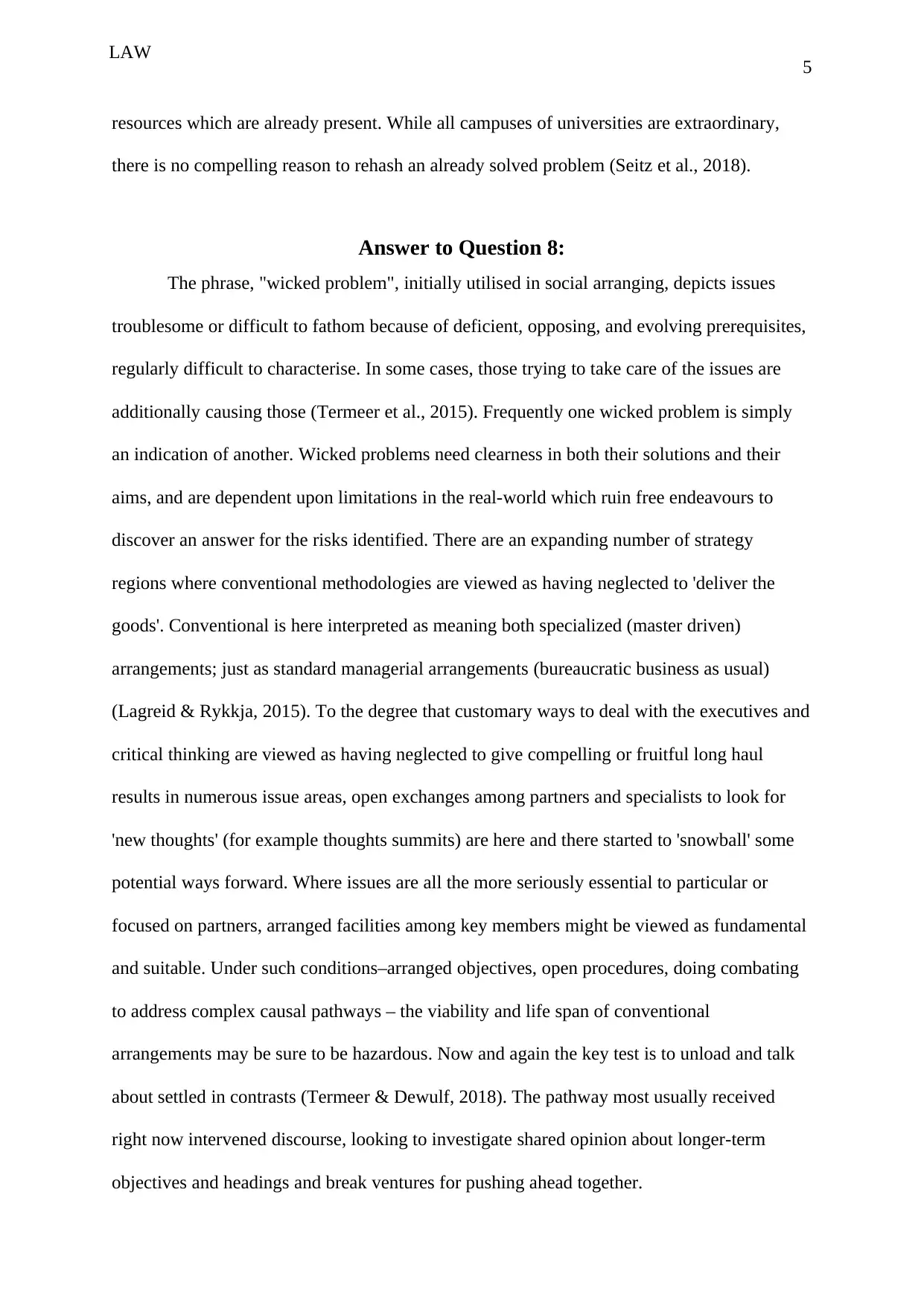
5
resources which are already present. While all campuses of universities are extraordinary,
there is no compelling reason to rehash an already solved problem (Seitz et al., 2018).
Answer to Question 8:
The phrase, "wicked problem", initially utilised in social arranging, depicts issues
troublesome or difficult to fathom because of deficient, opposing, and evolving prerequisites,
regularly difficult to characterise. In some cases, those trying to take care of the issues are
additionally causing those (Termeer et al., 2015). Frequently one wicked problem is simply
an indication of another. Wicked problems need clearness in both their solutions and their
aims, and are dependent upon limitations in the real-world which ruin free endeavours to
discover an answer for the risks identified. There are an expanding number of strategy
regions where conventional methodologies are viewed as having neglected to 'deliver the
goods'. Conventional is here interpreted as meaning both specialized (master driven)
arrangements; just as standard managerial arrangements (bureaucratic business as usual)
(Lagreid & Rykkja, 2015). To the degree that customary ways to deal with the executives and
critical thinking are viewed as having neglected to give compelling or fruitful long haul
results in numerous issue areas, open exchanges among partners and specialists to look for
'new thoughts' (for example thoughts summits) are here and there started to 'snowball' some
potential ways forward. Where issues are all the more seriously essential to particular or
focused on partners, arranged facilities among key members might be viewed as fundamental
and suitable. Under such conditions–arranged objectives, open procedures, doing combating
to address complex causal pathways – the viability and life span of conventional
arrangements may be sure to be hazardous. Now and again the key test is to unload and talk
about settled in contrasts (Termeer & Dewulf, 2018). The pathway most usually received
right now intervened discourse, looking to investigate shared opinion about longer-term
objectives and headings and break ventures for pushing ahead together.
LAW
resources which are already present. While all campuses of universities are extraordinary,
there is no compelling reason to rehash an already solved problem (Seitz et al., 2018).
Answer to Question 8:
The phrase, "wicked problem", initially utilised in social arranging, depicts issues
troublesome or difficult to fathom because of deficient, opposing, and evolving prerequisites,
regularly difficult to characterise. In some cases, those trying to take care of the issues are
additionally causing those (Termeer et al., 2015). Frequently one wicked problem is simply
an indication of another. Wicked problems need clearness in both their solutions and their
aims, and are dependent upon limitations in the real-world which ruin free endeavours to
discover an answer for the risks identified. There are an expanding number of strategy
regions where conventional methodologies are viewed as having neglected to 'deliver the
goods'. Conventional is here interpreted as meaning both specialized (master driven)
arrangements; just as standard managerial arrangements (bureaucratic business as usual)
(Lagreid & Rykkja, 2015). To the degree that customary ways to deal with the executives and
critical thinking are viewed as having neglected to give compelling or fruitful long haul
results in numerous issue areas, open exchanges among partners and specialists to look for
'new thoughts' (for example thoughts summits) are here and there started to 'snowball' some
potential ways forward. Where issues are all the more seriously essential to particular or
focused on partners, arranged facilities among key members might be viewed as fundamental
and suitable. Under such conditions–arranged objectives, open procedures, doing combating
to address complex causal pathways – the viability and life span of conventional
arrangements may be sure to be hazardous. Now and again the key test is to unload and talk
about settled in contrasts (Termeer & Dewulf, 2018). The pathway most usually received
right now intervened discourse, looking to investigate shared opinion about longer-term
objectives and headings and break ventures for pushing ahead together.
LAW
⊘ This is a preview!⊘
Do you want full access?
Subscribe today to unlock all pages.

Trusted by 1+ million students worldwide
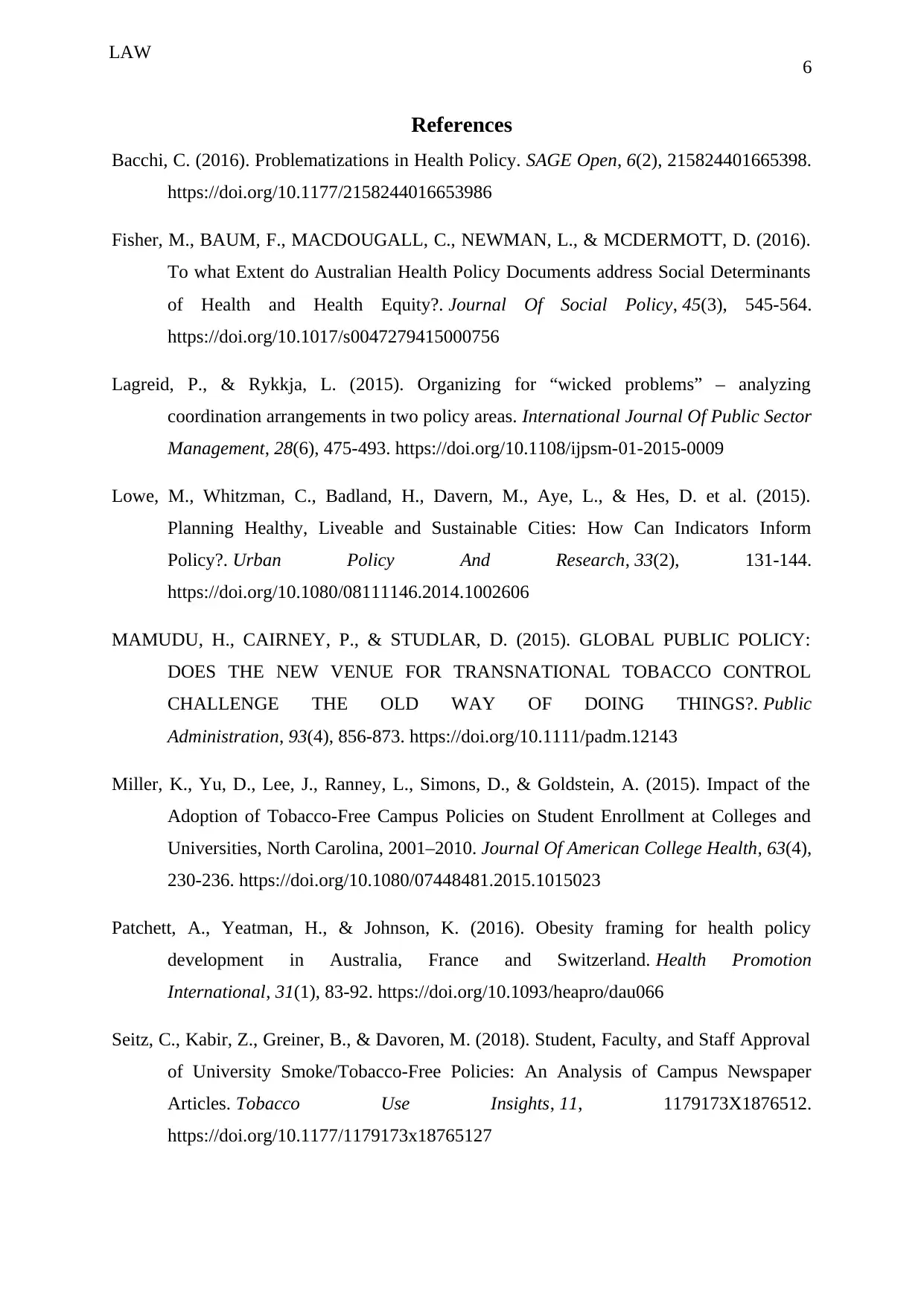
6
References
Bacchi, C. (2016). Problematizations in Health Policy. SAGE Open, 6(2), 215824401665398.
https://doi.org/10.1177/2158244016653986
Fisher, M., BAUM, F., MACDOUGALL, C., NEWMAN, L., & MCDERMOTT, D. (2016).
To what Extent do Australian Health Policy Documents address Social Determinants
of Health and Health Equity?. Journal Of Social Policy, 45(3), 545-564.
https://doi.org/10.1017/s0047279415000756
Lagreid, P., & Rykkja, L. (2015). Organizing for “wicked problems” – analyzing
coordination arrangements in two policy areas. International Journal Of Public Sector
Management, 28(6), 475-493. https://doi.org/10.1108/ijpsm-01-2015-0009
Lowe, M., Whitzman, C., Badland, H., Davern, M., Aye, L., & Hes, D. et al. (2015).
Planning Healthy, Liveable and Sustainable Cities: How Can Indicators Inform
Policy?. Urban Policy And Research, 33(2), 131-144.
https://doi.org/10.1080/08111146.2014.1002606
MAMUDU, H., CAIRNEY, P., & STUDLAR, D. (2015). GLOBAL PUBLIC POLICY:
DOES THE NEW VENUE FOR TRANSNATIONAL TOBACCO CONTROL
CHALLENGE THE OLD WAY OF DOING THINGS?. Public
Administration, 93(4), 856-873. https://doi.org/10.1111/padm.12143
Miller, K., Yu, D., Lee, J., Ranney, L., Simons, D., & Goldstein, A. (2015). Impact of the
Adoption of Tobacco-Free Campus Policies on Student Enrollment at Colleges and
Universities, North Carolina, 2001–2010. Journal Of American College Health, 63(4),
230-236. https://doi.org/10.1080/07448481.2015.1015023
Patchett, A., Yeatman, H., & Johnson, K. (2016). Obesity framing for health policy
development in Australia, France and Switzerland. Health Promotion
International, 31(1), 83-92. https://doi.org/10.1093/heapro/dau066
Seitz, C., Kabir, Z., Greiner, B., & Davoren, M. (2018). Student, Faculty, and Staff Approval
of University Smoke/Tobacco-Free Policies: An Analysis of Campus Newspaper
Articles. Tobacco Use Insights, 11, 1179173X1876512.
https://doi.org/10.1177/1179173x18765127
LAW
References
Bacchi, C. (2016). Problematizations in Health Policy. SAGE Open, 6(2), 215824401665398.
https://doi.org/10.1177/2158244016653986
Fisher, M., BAUM, F., MACDOUGALL, C., NEWMAN, L., & MCDERMOTT, D. (2016).
To what Extent do Australian Health Policy Documents address Social Determinants
of Health and Health Equity?. Journal Of Social Policy, 45(3), 545-564.
https://doi.org/10.1017/s0047279415000756
Lagreid, P., & Rykkja, L. (2015). Organizing for “wicked problems” – analyzing
coordination arrangements in two policy areas. International Journal Of Public Sector
Management, 28(6), 475-493. https://doi.org/10.1108/ijpsm-01-2015-0009
Lowe, M., Whitzman, C., Badland, H., Davern, M., Aye, L., & Hes, D. et al. (2015).
Planning Healthy, Liveable and Sustainable Cities: How Can Indicators Inform
Policy?. Urban Policy And Research, 33(2), 131-144.
https://doi.org/10.1080/08111146.2014.1002606
MAMUDU, H., CAIRNEY, P., & STUDLAR, D. (2015). GLOBAL PUBLIC POLICY:
DOES THE NEW VENUE FOR TRANSNATIONAL TOBACCO CONTROL
CHALLENGE THE OLD WAY OF DOING THINGS?. Public
Administration, 93(4), 856-873. https://doi.org/10.1111/padm.12143
Miller, K., Yu, D., Lee, J., Ranney, L., Simons, D., & Goldstein, A. (2015). Impact of the
Adoption of Tobacco-Free Campus Policies on Student Enrollment at Colleges and
Universities, North Carolina, 2001–2010. Journal Of American College Health, 63(4),
230-236. https://doi.org/10.1080/07448481.2015.1015023
Patchett, A., Yeatman, H., & Johnson, K. (2016). Obesity framing for health policy
development in Australia, France and Switzerland. Health Promotion
International, 31(1), 83-92. https://doi.org/10.1093/heapro/dau066
Seitz, C., Kabir, Z., Greiner, B., & Davoren, M. (2018). Student, Faculty, and Staff Approval
of University Smoke/Tobacco-Free Policies: An Analysis of Campus Newspaper
Articles. Tobacco Use Insights, 11, 1179173X1876512.
https://doi.org/10.1177/1179173x18765127
LAW
Paraphrase This Document
Need a fresh take? Get an instant paraphrase of this document with our AI Paraphraser
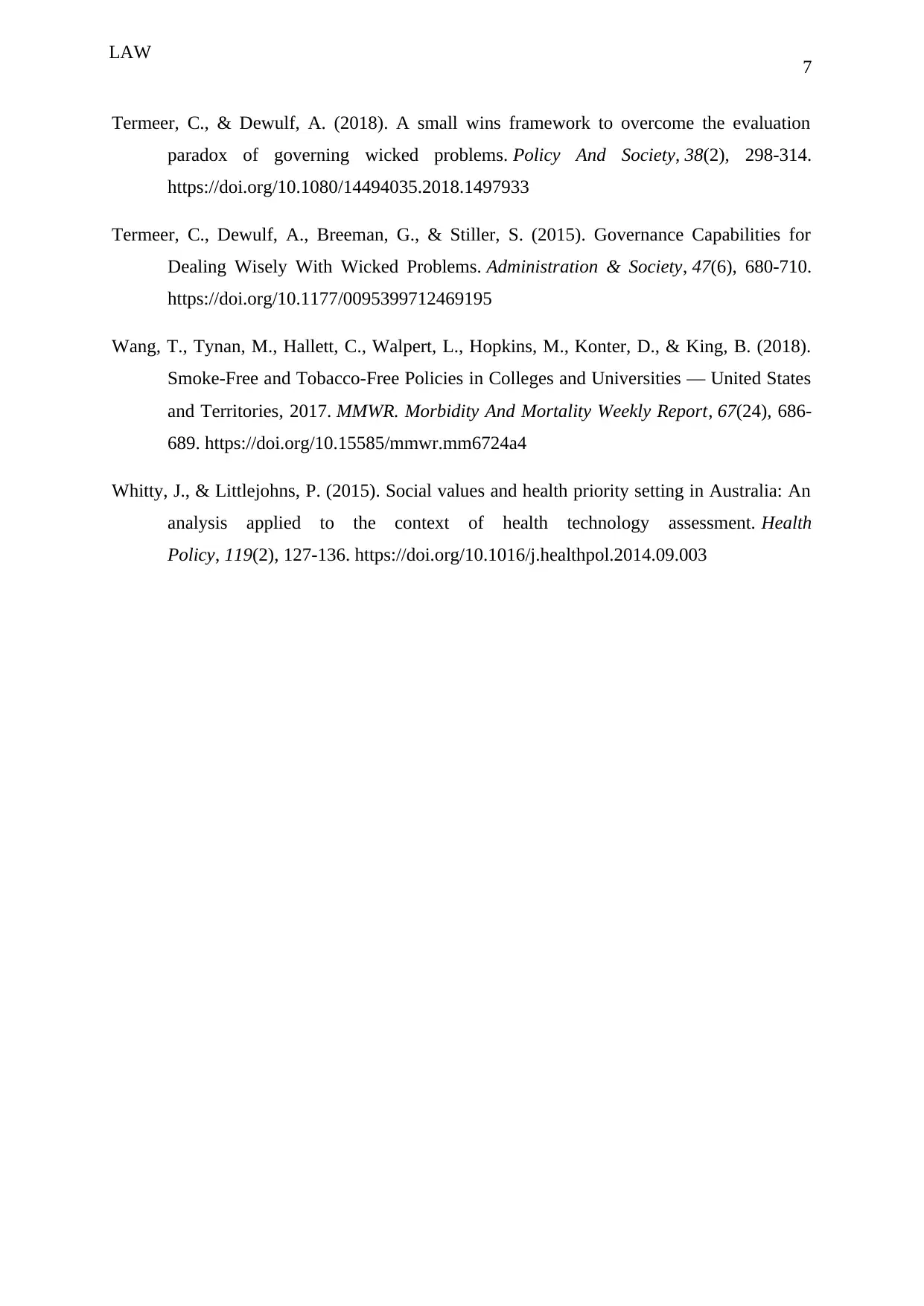
7
Termeer, C., & Dewulf, A. (2018). A small wins framework to overcome the evaluation
paradox of governing wicked problems. Policy And Society, 38(2), 298-314.
https://doi.org/10.1080/14494035.2018.1497933
Termeer, C., Dewulf, A., Breeman, G., & Stiller, S. (2015). Governance Capabilities for
Dealing Wisely With Wicked Problems. Administration & Society, 47(6), 680-710.
https://doi.org/10.1177/0095399712469195
Wang, T., Tynan, M., Hallett, C., Walpert, L., Hopkins, M., Konter, D., & King, B. (2018).
Smoke-Free and Tobacco-Free Policies in Colleges and Universities ― United States
and Territories, 2017. MMWR. Morbidity And Mortality Weekly Report, 67(24), 686-
689. https://doi.org/10.15585/mmwr.mm6724a4
Whitty, J., & Littlejohns, P. (2015). Social values and health priority setting in Australia: An
analysis applied to the context of health technology assessment. Health
Policy, 119(2), 127-136. https://doi.org/10.1016/j.healthpol.2014.09.003
LAW
Termeer, C., & Dewulf, A. (2018). A small wins framework to overcome the evaluation
paradox of governing wicked problems. Policy And Society, 38(2), 298-314.
https://doi.org/10.1080/14494035.2018.1497933
Termeer, C., Dewulf, A., Breeman, G., & Stiller, S. (2015). Governance Capabilities for
Dealing Wisely With Wicked Problems. Administration & Society, 47(6), 680-710.
https://doi.org/10.1177/0095399712469195
Wang, T., Tynan, M., Hallett, C., Walpert, L., Hopkins, M., Konter, D., & King, B. (2018).
Smoke-Free and Tobacco-Free Policies in Colleges and Universities ― United States
and Territories, 2017. MMWR. Morbidity And Mortality Weekly Report, 67(24), 686-
689. https://doi.org/10.15585/mmwr.mm6724a4
Whitty, J., & Littlejohns, P. (2015). Social values and health priority setting in Australia: An
analysis applied to the context of health technology assessment. Health
Policy, 119(2), 127-136. https://doi.org/10.1016/j.healthpol.2014.09.003
LAW
1 out of 8
Related Documents
Your All-in-One AI-Powered Toolkit for Academic Success.
+13062052269
info@desklib.com
Available 24*7 on WhatsApp / Email
![[object Object]](/_next/static/media/star-bottom.7253800d.svg)
Unlock your academic potential
Copyright © 2020–2025 A2Z Services. All Rights Reserved. Developed and managed by ZUCOL.





